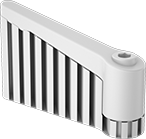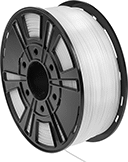Structural Support 3D Printer Filaments

with your part to prevent the
part from losing its shape

When 3D printing a model with overhangs or hollow spaces, use these filaments to prevent the model from losing its shape. They support the structure during the printing and cooling process, then dissolve or snap away once the part is hardened. Use them in dual-extrusion fused filament fabrication (FFF) printers alongside your primary filament. Unlike parts with supports printed from a single filament, there’s no cutting, sanding, or polishing required.
Choose a filament that has similar printing requirements as your primary filament. You will want to choose a support filament that prints at a similar temperature as your primary filament and has the same requirements for a heated build chamber, so they cool at the same rate and won’t warp. Aquasys 180 filaments work with high-temperature plastic, such as PEEK, PEI, and PPS. They require a heated build chamber. PSU blend filaments work with high-temperature plastic, such as PEEK and PEI, and require a heated build chamber.
You should also consider how you will remove the structural support filament from your finished part. Soluble filaments are well suited to print parts with complex or fragile designs as they gently dissolve off your primary part, leaving a smooth finish. Water-soluble filaments dissolve in a heated bath. Break-away filaments are designed to cleanly snap off of your primary parts with your hands while the print is still warm, taking only minutes to fully remove.
Spool | ||||||||||||
|---|---|---|---|---|---|---|---|---|---|---|---|---|
| Dia., mm | Printing Temp. | For Printer Bed Temp. | Hardness | Max. Exposure Temp. | Water Temp. to Dissolve | For Min. Nozzle Opening Dia., mm | Dia., mm | Dp., mm | Wt., g | For Use With | Each | |
Water Soluble | ||||||||||||
Aquasys 180—Opaque Amber | ||||||||||||
| 1.75 | 230° to 300° C 446° to 572° F | 60° to 180° C 140° to 356° F | Not Rated | 70° C 158° F | 80° C 176° F | 0.4 | 200 | 55 | 500 | PEEK Plastic PEI Plastic PEKK Plastic PPS Plastic PPSU Plastic | 0000000 | 0000000 |
| 2.85 | 230° to 300° C 446° to 572° F | 60° to 180° C 140° to 356° F | Not Rated | 70° C 158° F | 80° C 176° F | 0.4 | 200 | 55 | 500 | PEEK Plastic PEI Plastic PEKK Plastic PPS Plastic PPSU Plastic | 0000000 | 000000 |
Break Away | ||||||||||||
PSU Blend—Clear | ||||||||||||
| 1.75 | 350° to 380° C 662° to 716° F | 120° to 160° C 248° to 320° F | Rockwell R125 (Hard) | 180° C 356° F | __ | 0.4 | 200 | 35 | 500 | PEEK Plastic PEI Plastic PEKK Plastic PPS Plastic PPSU Plastic PSU Plastic | 0000000 | 000000 |



























